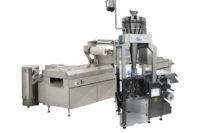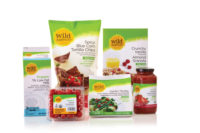“If you go into a Walgreens or CVS, try walking down the aisle. You may see recloseable flexible packages failing on the shelf – if you know what to look for, you can find them more often than you would expect. That’s because somebody didn’t do their homework. You’ll see things like ‘tenting,’ where you can see the effects of the chemistry inside the package coming up through the opening in the film and attacking the base of the label. You’re going to see what we call ‘tunneling,’ where the liquid is leaking out either in liquid or vapor form under the edge of the label. You might see discoloration of the towels or the film. When you peel the label back, you might leave the adhesive behind, or you might pull the polyester right off the surface of the film because the film is delaminating.”
That’s Scott Hetherton, general manager at Pewaukee, Wisconsin-based HFM Packaging, a converter that has particularly established itself in recloseable flexible packaging.
HFM is celebrating its 40th anniversary in business this year, having been founded by Harvey F. Martinez. While the early roots of the company can be traced back to Martinez’s basement and garage, today HFM works out of a 35,000-square-foot facility in Pewaukee – and its 25 person staff helps develop packaging for a wide range of markets, such as healthcare, industrial, and beauty and personal care.
When HFM got involved in the peel and reseal market some 20 years ago, it wasn’t so much involved in the development that was existing, but in new developments that could package harder to hold products.
“There was already packaging on the market, but it was primarily for baby wipes,” reflects Paul Martinez, HFM president and son of Harvey F. Martinez. “There was a commonly available label that worked just fine for simple soap and water applications, but wouldn’t hold up to more aggressive solutions.”
Some examples of harder to hold materials that HFM wanted to package included things like household cleaners and industrial wipes that were saturated with alcohol.
“These laminates and these labels that were commonly available at the time didn’t hold up to these other solutions,” continues Martinez. “The film would either delaminate or the label would come off. We had to design systems that would resist delamination and attack of the adhesive system and function in a resealable situation for multiple reseals.”
While the wet wipes market has historically been the main focus of HFM’s business when it comes to peel and reseal labels, it’s a development that began about three years ago that’s now becoming more popular. Hetherton says that’s when a company approached HFM about its technology as it pertains to a peel and reseal lidstock on a tray with an easy-open lift tab.
“What we brought to the table was the ability to do that process in a very unique way,” Hetherton explains. “Historically, when people did a peel and reseal lidstock on a tray, that peel and reseal lidstock was done using a process where they’d apply the label first, then cut through the film from the back side. That’s still prevalent today, but that has a lot of potential problems. These are barrier materials, so they have oxygen barrier to keep the food fresh and keep it from spoiling, and when you cut through the film and into the label, you can compromise the label integrity. This has caused major problems with some products in the past.”
It’s these problems that Hetherton speaks of that caused the customer to approach HFM to see if a different solution could be applied.
Hetherton continues: “Because of our experience in hard to hold products, we use a unique process that doesn’t compromise package integrity. When we produce a package, we always know that we are not diminishing the essential material properties. That’s fairly unique. These lidstock products that we convert run on machines that are 1 to 4 lanes across that are filling a dozen or so trays at a time. We took our existing custom high-speed equipment designed for horizontal form-fill machines and we customized it once again to make it compatible with multi-lane technology. Now we are producing multi-lane versions of lidstock material for the food market. We pre-convert the lidstock so the filler doesn’t have to, which increases the efficiency and reliability of their process.”
The end result is a tray package that isn’t just easy for packagers to fill, but one that can be opened and resealed again and again by the consumer. What’s more is that there are lots of applications for this resealable tray beyond the food markets where it’s currently being deployed. Today HFM is introducing the use of pre-formed trays in addition to trays made from a forming web.
HFM Packaging
(262) 547-6300
www.hfmpackaging.com
HFM Packaging
Location: Pewaukee, Wisconsin
Markets: Healthcare, Beauty, Industrial, Personal Care, Food & Beverage
Specialties: Recloseables, Standup Pouches, Lidstock
Employees: 25




